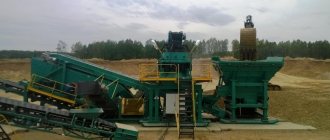General provisions
1.1. The crane operator is a worker and reports directly to
___________________________________.
(to the head of the logging station; to another person)
1.2. The crane operator must know:
— design, design features, operating rules, purpose and principle of operation of loading machines, cranes of all types, self-propelled loaders of various systems;
— methods of regulating pumps, valves of used machines and mechanisms during operation;
— methods of performing work on transportation, loading, stacking of wood;
— technical conditions for the operation of ropes;
— control schemes and maximum loads of cranes and ropes;
— rules for loading vehicles, couplings, wagons, platforms;
— causes of malfunctions of serviced machines and mechanisms, ways to eliminate them;
— requirements for the use of protective equipment;
— methods and techniques for performing work safely;
— the procedure for notifying the manager of all deficiencies discovered during work;
— rules for providing first (pre-medical) aid to victims of injury, poisoning and sudden illness;
— Internal labor regulations;
— rules of labor protection, industrial sanitation and personal hygiene, fire safety;
— ____________________________________________________________________.
(types, names and details of other acts and documents)
1.3. _____________________________________________________________________.
IV. Responsibility
A 4th category chipping machine operator is responsible for:
1. For improper performance or failure to fulfill one’s job duties provided for in this job description - within the limits determined by the current labor legislation of the Russian Federation.
2. For offenses committed in the course of carrying out their activities - within the limits determined by the current administrative, criminal and civil legislation of the Russian Federation.
3. For causing material damage - within the limits determined by the current labor and civil legislation of the Russian Federation.
4. ____________________________________________________________________
This job description has been developed in accordance with the provisions (requirements) of the Labor Code of the Russian Federation dated December 30, 2001 No. 197 FZ (Labor Code of the Russian Federation) (with amendments and additions), the professional standard “Forest processing equipment operator” approved by order of the Ministry of Labor and Social Protection of the Russian Federation Federation dated December 21, 2020 No. 1078n and other regulations governing labor relations.
Responsibilities
2.1. Before the start of the working day (shift), the crane operator:
1) receives a production task, gets acquainted with the technological map of the work;
2) if necessary, undergoes training on labor protection;
3) checks the condition of fasteners, hydraulics, connecting pipes, hoses, junction boxes, brakes, timber loader attachments, cabin protection, serviceability of the sound signal, serviceability of other tools, devices, equipment, etc., personal protective equipment;
4) ___________________________________________________________________.
(other duties)
2.2. During work, the crane driver:
1) uses special clothing, safety shoes and other personal protective equipment;
2) receives instructions from the immediate supervisor on the performance of the task, safe techniques and methods of work;
3) complies with the rules for using technological equipment, devices and tools, methods and techniques for performing work safely;
4) become familiar with the work area and mark it with warning and prohibition signs;
5) make sure that the timber transport is correctly installed for loading and that there are no people in the danger zone;
6) gives an audible signal about the start of loading and subsequently during loading is guided by the driver’s signals;
7) immediately notify his immediate supervisor of all deficiencies discovered during work;
 complies with the requirements of personal hygiene and industrial sanitation;
complies with the requirements of personal hygiene and industrial sanitation;
9) provides first (pre-medical) aid to victims of injury, poisoning in emergency situations and sudden illness;
10) __________________________________________________________________.
(other duties)
2.3. During the working day (shift), the crane operator
4th category:
1) controls loading machines or cranes of all types with a lifting capacity of up to 2 tons, self-propelled loaders of various systems mounted on tractors, when hauling, loading onto timber transport, unloading timber, forest chemical products, stumps and tar from timber transport rolling stock, piling wood onto warehouses with direct participation in the implementation of the technological process of logging;
2) regulates lifting mechanisms and loading devices;
3) checks the reliability of ropes, blocks, chokers, lifting mechanisms and devices;
4) takes part in carrying out all types of maintenance and repair of used mechanisms of machines and equipment;
5) identifies and eliminates malfunctions of serviced lifting mechanisms, machines and devices;
6) ___________________________________________________________________;
(other duties)
5th category:
1) manages:
— loading machines or cranes of all types of all types with a lifting capacity of over 2 tons;
— tower stationary and gantry cranes with a lifting capacity of over 5 to 25 tons for stacking, loading, reloading and transporting timber cargo and other similar cargo using flexible slings and in bags in lower warehouses;
2) performs the duties specified in paragraphs 2 - 6 for a crane operator of the 4th category;
3) ___________________________________________________________________;
(other duties)
6th category:
1) manages:
— self-propelled loaders of various systems mounted on tractors, loading machines and cranes of all types with a lifting capacity of over 5 to 7 tons when performing work on loading, unloading, stacking, reloading and transporting timber and other similar cargo;
— tower stationary and gantry cranes with a lifting capacity of over 25 tons, equipped with various lifting devices, when performing work on loading, unloading, stacking, reloading and transporting timber and other similar cargo;
— tower stationary and gantry cranes with a lifting capacity of up to 5 tons, equipped with grabs, in lower warehouses, during stacking, loading, unloading, reloading and transportation of timber cargo;
— cable cranes with a lifting capacity of over 10 tons when performing all types of work;
2) performs the duties specified in paragraphs 2 - 6 for a crane operator of the 4th category;
3) ___________________________________________________________________;
(other duties)
7th category:
1) manages:
— self-propelled loaders of various systems mounted on tractors, loading machines and cranes with a lifting capacity of over 7 tons in lower warehouses, during stacking, loading, unloading, reloading and transportation of timber cargo;
— tower stationary and gantry cranes with a lifting capacity of over 5 tons, equipped with grabs, in lower warehouses, during stacking, loading, unloading, transhipment and transportation of timber cargo;
2) performs the duties specified in paragraphs 2 - 6 for a crane operator of the 4th category;
3) ___________________________________________________________________;
(other duties)
2.4. At the end of the working day (shift), the crane operator:
1) places the log loader in the designated parking area and secures the boom (lowers the jaws to the ground);
2) turns off the engine, brakes the log loader, and locks the cab;
3) after an external inspection of the loader, determines the presence of malfunctions and reports them to the mechanic (if it is impossible to eliminate them independently);
4) removes and stores protective clothing and other personal protective equipment;
5) performs hygiene procedures, performs inspection (self-examination);
6) ___________________________________________________________________.
(other duties)
BEGINNING OF WORK
1.1 Before starting work, the crane operator must familiarize himself with the entries in the logbook, accept the crane, and make sure that all mechanisms, metal structures, components and other parts of the crane, as well as the crane runway, are in good working order.
1.2 Before putting the crane into operation, the crane operator is obliged to dry-test all the mechanisms of the crane and check the correct operation:
- crane mechanisms and electrical equipment;
- brakes for lifting and moving mechanisms;
- interlocks, signaling devices, instruments and safety devices available on the crane.
- The proper functioning of the limit switch of the lifting mechanism is checked by lifting the hook suspension without a load. In this case, the distance from the suspension after it stops to the stop must be at least 200 mm. Based on the results of the check, an entry must be made in the logbook indicating the actual distance;
- inspect the crane mechanisms, their fastenings and brakes, as well as the chassis and anti-theft grips;
- check the presence and serviceability of mechanism guards and the presence of dielectric mats in the cabin;
- check whether the gears, bearings and ropes are lubricated, as well as the condition of the lubricating devices and seals;
- inspect the metal structures of the crane, welded, riveted and bolted connections in accessible places;
- check the condition of the ropes and their fastening on drums and other places. In this case, you should pay attention to the correct laying of ropes in the streams of blocks and drums;
- inspect the hook, its fastening in the cage and the closing device on it or another replaceable load-handling device installed instead of the hook;
- check the presence of locks, instruments and safety devices on the crane;
- check the serviceability of the lighting of the crane and work area;
- visually inspect the crane tracks and dead-end stops (general condition of the crane track; rail defects; completeness, integrity of the crane track elements and their fastenings; condition of the crane equipment; integrity of the grounding device);
- inspect electric motors in accessible places, trolleys or flexible current supply cables, pantographs, control panels, protective grounding, check whether the doors of the protective panel cabinets, main switches, magnet panels and hatches of the main pantograph service areas are locked;
- zero blocking magnetic controllers;
- emergency switch and contact lock with key mark.
1.3 If, during inspection and testing of the crane, faults are discovered that impede safe operation, the crane operator, without starting work, must make an entry in the logbook and notify the person responsible for the safe performance of work with cranes, and the engineer and technical worker responsible for the maintenance of lifting equipment. cars are in good condition.
1.4 Having accepted the crane, the crane operator must make an appropriate entry in the logbook about the results of the inspection and testing of the crane and, after receiving the assignment and permission to work from the person responsible for the safe performance of work with cranes, begin work.
Locomotive driver
Ensuring that trains pass exactly on schedule, that the weight and length of the vehicle are maintained, as well as the execution of all orders and instructions from management and workers coordinating movement on the tracks are the responsibilities of the locomotive driver. The employee must check for obstacles on the way, check and follow traffic lights and other signs, including adhering to the stated speed limit. If a locomotive passes through a station or crossing, the employee must sound the appropriate signal and carefully check for obstacles on the way, so that if they are present, he can stop the vehicle in a timely manner.
The employee is obliged to monitor the serviceability of the locomotive, and if problems are detected, report this to the dispatcher of the nearest station. It is the responsibility of the train driver to reduce the speed of the vehicle if weather conditions do not allow normal vision of road signs and traffic lights. It must ensure the serviceability of communication devices, tools and equipment, as well as safety equipment, regulate the consumption of fuel and other materials. After completing the locomotive route, the employee must hand over all the necessary documents and equipment to the duty depot.








